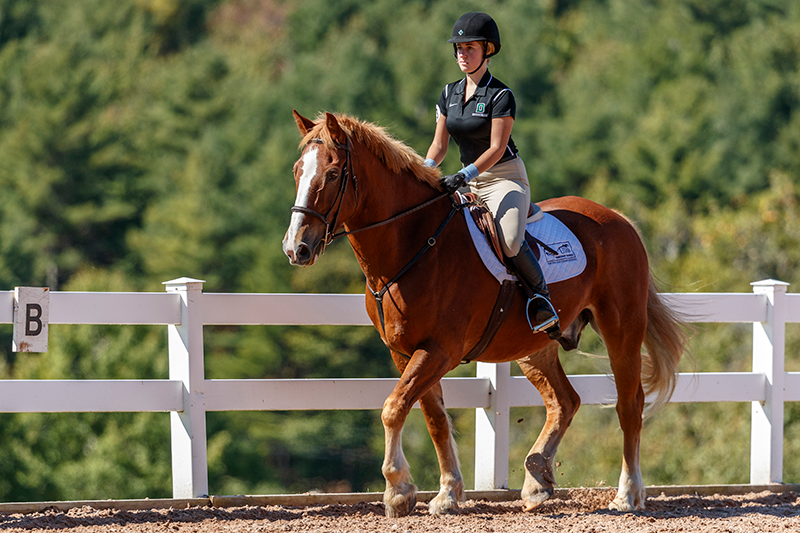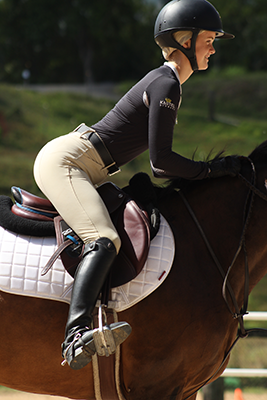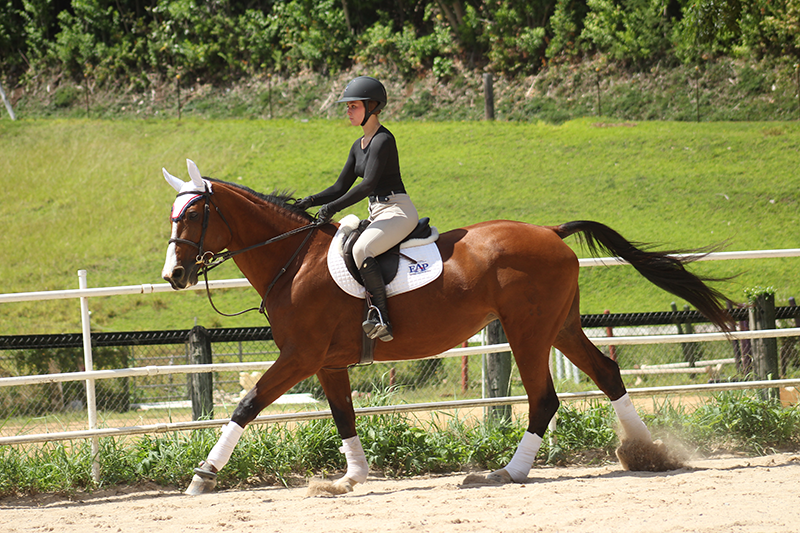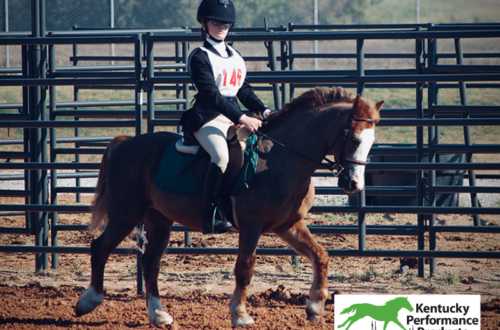
Improve Your Hunter Seat Equitation Skills
By Christina Keim, USPC National Examiner
Photos Reprinted with permission from the book The Athletic Equestrian, By Sally Batton and Christina Keim; Courtesy Trafalgar Square Books (HorseandRiderBooks.com)
The Hunter Seat Equitation (HSE) discipline emphasizes the development of correct rider form and technique in order to help the horse perform consistently, accurately, and with technical proficiency over fences. In the United States, HSE is perhaps one of the most popular equestrian disciplines for junior riders. Developing correct equitation can be a goal unto itself or serve as a stepping stone to performance in the hunter or jumper rings.
The United States Pony Clubs (USPC or Pony Club) HSE Standards of Proficiency prioritize skills related to arena jumping. Flatwork expectations focus on the rider’s ability to influence rhythm, balance, pace, and line. HSE riders often demonstrate a higher level of proficiency in their arena jumping skills compared to riders in other disciplines at the same level. In the open, HSE riders must demonstrate confidence and control at the walk and trot; they are not expected to canter or jump.
Through all phases, HSE riders generally ride in jumping tack, with a shorter stirrup and closed angles at the ankle, knee, and hip. On the flat, the HSE rider keeps a soft forward tip at the hip, resulting in a slightly forward angle in the rider’s upper body. They do not sit as deeply in the saddle as their Dressage or Eventing counterparts, and on a jumping course, they typically remain in a light seat between fences.
D-Level Riding Expectations
D-level members in all disciplines are at the beginning of their horsemanship journey. D’s are establishing a correct foundation of safe habits and the ability to ride independently, with a reasonably secure position at the walk, trot, and canter. D’s are still developing balance, strength, and suppleness on the horse, and are learning the fundamentals of position. Therefore, their aids typically lack coordination and finesse, and at times their position can seem stiffer or more mechanical. This is normal and all part of the process of learning to ride!

The D-2 HSE Expectations on the Standards of Proficiency state: Candidate should ride in a Hunter Seat Equitation position in an enclosed arena demonstrating control at the walk and trot and should begin to develop the canter and two-point position. No need to canter over fences.
HSE riders looking toward D-2 will be focusing mostly on their position in the saddle, with special emphasis on the lower leg. In HSE, the rider’s lower leg serves as the foundation for the rest of their position; establishing a steady, stable lower leg takes a great deal of thoughtful repetition and correction. Therefore, it is not expected that a D-2 will have full control of their lower leg position. See “D-2 Lower Leg Fundamentals” below.
D-2 HSE riders are still figuring out the biomechanics (or the structure, function, and motion) of their riding position, and often lack the required strength to hold their lower legs back, down, and in against the horse’s side. It is common to see the lower leg sliding ahead or behind the ideal alignment, particularly if the rider has lost the correct foot placement in the stirrup.
The D-2 HSE standard requires riders to demonstrate the fundamentals of two-point at the walk and trot, and over poles. This position will become one of the most important tools for the HSE rider. However, at the D-2, it is common that the rider’s two-point lacks balance, is held ahead of center, or demonstrates incorrect biomechanics, such as standing up in the stirrups.
D-2 HSE Lower Leg Basics
- To position your foot correctly in the stirrup, the toe and ball of the foot should be through the iron at about a 45° angle; the outside branch of the stirrup is a little forward with the inside branch a little further back.
- Lower weight, or focus, your weight downward into the heel and lift the toe.
- Your lower leg should hang beneath your hip.
The stirrup leather should be perpendicular to the ground, with the knee centered over the ball of the foot. You should keep contact with the horse’s barrel
The stirrup leather should be perpendicular to the ground, with the knee centered over the ball of the foot. You should keep contact with the horse’s barrel.
The D-3 HSE Expectations on the Standards of Proficiency state: Candidate should ride in a Hunter Seat Equitation position with control at the walk, trot, and canter. Candidate should demonstrate a secure base of support while developing balance and a steady position on the flat and over fences.
When a member is approaching the D-3 certification level in HSE, not only are the fundamentals of the rider’s position more firmly established, they can now use this foundation to successfully navigate basic courses consisting of straightforward lines and simple turns over small fences, including verticals and small spreads. This skill set is developed through consistent repetition of simple jumping exercises, work over cavaletti, and plenty of two-point practice. See “D-3 HSE Benchmarks” below.
D-3 HSE members are enthusiastic equestrians, who are often starting to feel secure and capable enough to ride more independently with their mounts. Their position and overall balance on the horse is still developing, and their use of aids is often not finessed; ideally, they are still partnered with seasoned, reliable mounts that are forgiving of a newer rider’s mistakes.
D-3 HSE Benchmarks
When you reach the D-3 level in Hunter Seat Equitation, you can show:
- Increased proficiency at the canter (including use of the half seat/light seat between fences).
- Increased stability and consistent correct alignment of the lower leg.
- Elementary use of aids to create basic bending and change of the mount’s speed at the walk and trot.
- Competency in jumping basic courses of verticals and spreads at the canter.

C-Level Riding Expectations
After developing a solid position at the D levels, a C-level HSE rider is now learning to use their position to positively influence the horse. They demonstrate fairly consistent stability and security in the saddle, leading to more independent, coordinated aids, and a higher degree of confidence and control than a D-level rider. Through their discussion, they show a greater awareness of how their position and aids can either help or hinder the horse.
It is common for members working toward the C-level certification to “move up” from a beginner’s mount to one capable of more athletic performance. As riders adjust to their new mount’s longer stride or bigger jump, it can seem as though they backslide in their skills. Again, this is a normal part of rider progression; through coaching and practice, the rider will learn to adapt to the new mount’s way of going, and previous skills will “reappear.”*
The C-1 HSE Expectations on the Standards of Proficiency state: Candidate should ride with confidence and control on the flat and over fences, demonstrating a Hunter Seat Equitation position and use of natural aids. The candidate should begin riding the mount forward in balance and rhythm while developing a light contact.
A C-1 HSE rider is learning that how they ride influences the horse. On the flat, they are learning to establish a positive forward rhythm and balance in the horse sufficient to jump a 2’9″ course. Over fences, the rider is becoming comfortable with related distances, including basic combinations, as well as common equitation tests, such as trot fences and halts on course. They can now thoughtfully discuss their mount’s energy, bending, balance, and responsiveness, and understand how their aids influence these qualities.
C-1 HSE riders are still learning to coordinate their aids, and therefore will likely have moments when communication with the horse isn’t totally harmonious. In HSE, the horse’s performance is considered to be the direct result of the rider’s performance. Therefore, in discussion, C-level HSE members may be hyper-critical of their riding. Instructors should be sure to help them recognize where their performance is going well, alongside a thoughtful discussion of those skills that are still developing.
The C-2 HSE Expectations on the Standards of Proficiency state: Candidate should ride with confidence and control on the flat and over fences, demonstrating a secure Hunter Seat Equitation position and progress toward an independent seat and coordinated use of aids. Candidate should ride mount forward, establishing rhythm and elasticity while maintaining contact.
The C-2 HSE rider is becoming a thinking equestrian, with an ever-increasing awareness of how subtle changes in their position can positively or negatively impact the horse.
C-2 riders are developing increased sophistication and skill in jumping courses and should have fairly precise control of the horse’s rhythm, balance, pace, and line—both on the flat and over fences. In discussions about their riding, the C-2 HSE rider shows a strong understanding of how their position and aids influence the horse, and their “audio” (what is said) matches the “video” (what the rider does).
Riders at this level not only demonstrate a secure position, they ride with a degree of softness and ease due to increasing independence in their aids. An observer will see the result of the rider’s aids in the horse’s performance, but not necessarily notice their application.

The Show Jumping Specialty
Working through the local-level HSE certification levels sets up members with a foundation of skills and knowledge that could lead them to pursue the national-level C-3, B, and A Show Jumping certifications. A full discussion of the expectations at these levels is beyond the scope of this article, but for members with a strong passion for arena jumping, the upper-level Pony Club Standards of Proficiency for Show Jumping challenge them to develop progressively more precise skills over larger fences and more technical courses while working with various types of horses.
Whether a Hunter Seat Equitation rider, or a rider of another discipline within Pony Club, wants to progress through all the levels, or has other goals, Pony Club’s Standards of Proficiency provide guidelines for rider skills, as well as Horse Management skills. These guidelines provide a succinct progression for each and every rider, regardless of level. Understanding the Standards and the practical applications of what they say helps every rider on their journey with horses.
This article on Hunt Seat Equitation was originally published in the 2023 Bonus Digital issue of Discover USPC magazine. Read more content from that issue.
This is an excerpt from the book The Athletic Equestrian, By Sally Batton and Christina Keim, published by Trafalgar Square Books / HorseandRiderBooks.com. When you shop from HERE, Pony Club receives a 15% commission on all you buy.



